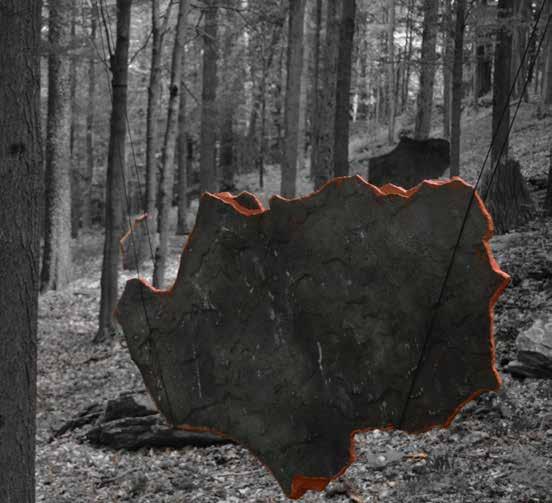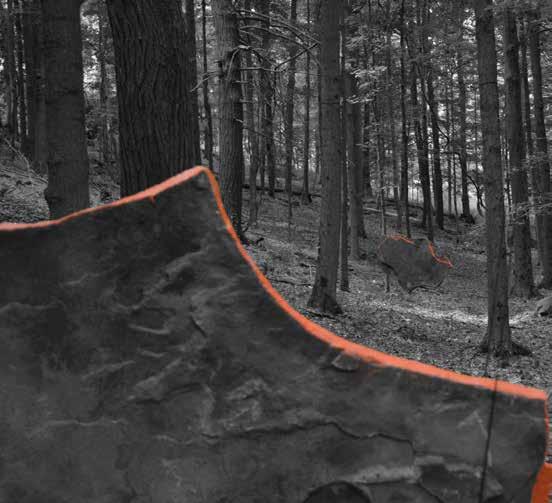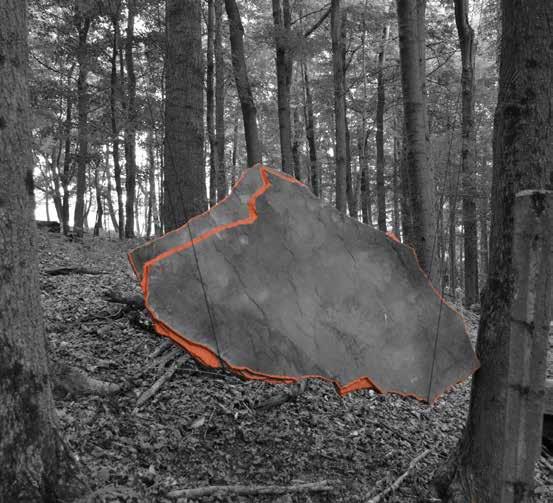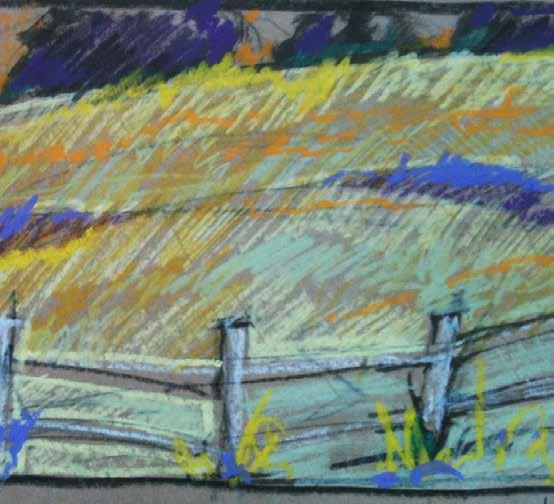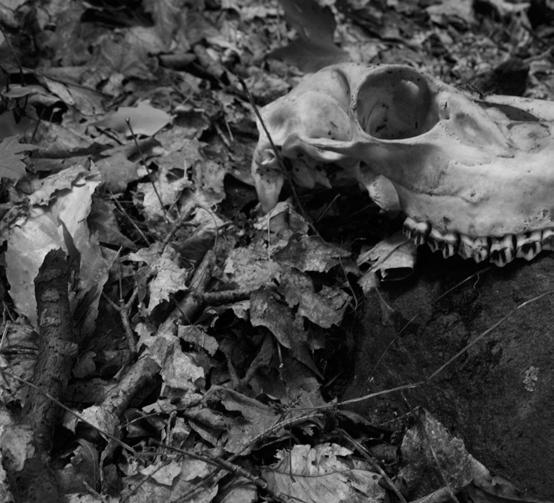
OUT OF THE WOODS
Out of the Woods investigated sustainable forestry at the spatial scale of small woodlands and family forests and the temporal scale of old growth forests. We studied public perception and participation in developing forest management policies and practices; land planning for forest ecosystems that straddles human needs, such as recreation, hunting, timber, and spiritual renewal, with the needs of other species and the intrinsic values of the forest; visualization across spatially and temporally distant landscapes and events; and expansion of environmental literacy and stewardship through community outreach and education. Students produced forest trajectories – past, present, and future transects of a second-growth forest linking climate, geomorphology, ecological processes, human-instigated and natural disturbance regimes, and material production.
That classroom and forest-based research was the foundation for a summer field school at Overlook, a 400-acre property originally designed by the Olmsted firm, in rural Pennsylvania. There, seven graduate and three undergraduate landscape architecture students created an exhibition of art inspired by, revealing, and critiquing the regional forests. As in the spring seminar, we collaborated with local experts from regional universities, tree farms, nature preserves and conservancies to translate the lessons from spring to a new context and medium.
Following a field research period, students spent two weeks designing and installing art projects, which coalesced around four themes:w
Locational specificity: artworks about specific species of trees and insects, about the voracious deer population, or the regional geomorphology reveal the need for forest design to be deeply rooted in the specific biotic and edaphic conditions of a place.
Temporal specificity: Several projects dealt with the synchronic site: the forest as it is, experienced subjectively, only for a moment. The phenomenal qualities of a site continually shift, creating a forest that can never be experienced again.
Engagement and interruption: Forests, like all landscapes, are a collection of processes in motion. Several artworks highlighted those processes, either engaging and enhancing them or interrupting them. Some works did both – light studies at night simultaneously attracted insects, enhancing the perception of nocturnal moths and cicadas, and interrupted the anonymity of darkness.
The invisible present: Many of the processes of the forest are slow, taking place over decades. Their movement is invisible, yet very powerful. Emerald ash borer kill, deer browse, and a future condition is already in creation. Several works highlighted the agents already acting on the regional forests.

THE COTTAGE
Nick DrummondConstructed in 1902 and expanded in 1919, the original Cottage was the the main residence at Overlook, though a newer, more practical house has since replaced it. This piece was made not only to remember this fallen artifact, but also in an effort to gain a more tactile understanding of the interconnectedness of architecture, landscape, and time.
Buildings are, in fact, an assemblage of manipulated landscape materials; choreographed to both shape and adhere to human and natural processes. The pale yellow leaves of the surrounding Katsura trees illuminate the structure in the early fall, with a new effect brought forth by the snowfall in winter. And eventually, like its predecessor, The Cottage will fall victim to time, collapsing, rotting, and fading from view.




SING CANARY
Emma FrohEstates such as Overlook seem like properties suspended in time. The grand sweep of beautifully maintained pastures, meadows, and gardens gives the impression of a bucolic utopia unmarred and untouched by change. In reality, Overlook is in a state of constant flux. Much of the change and evolution is occurring at a rate and scale outside of the realm of human perception. Accordingly, the change also occurs outside of the dominion of human control.
Sing Canary desires to uncover these ordinarily imperceptible shifts through focused attention. The artwork manifests the complex feelings provoked by a confrontation with uncontrollable change. A sited architectural form and a video piece speak to underlying emotions including the longing for protection, the seduction of denial, and the fear of unrecoverable loss.
To access the ideal vantage point for the projection screen, the visitor must weave through a narrow switchback passage encased in a structure modeled after a deer blind. The allusion to a familiar Pennsylvanian structure is meant to invite observation and contemplation. Bottles containing potions and tinctures line the interior walls, supernaturally warding off undesirable evils.




PREVIEW
Patty HinesIn just a few years, the emerald ash borer will destroy all of the ash trees in the northeastern United States. The invasive beetle will then head west, and, become another in a long line of insects that have plagued the great hardwood forests. An entire species of tree will again be eradicated. White ash trees comrise approximately 70 percent of the forest on the 400-acre Overlook Estate. All of those trees will soon be gone.
Preview is a haunting reminder of “the invisible present” (Magnuson 1990) and the future loss of the forest primeval. Long bands of matte-black material wrap the trunks of the ash trees, highlighting the future void in the forest. Black fabric represents death, like wearing a black armband worn in remembrance of a loved one who has died. The devastation, emptiness, and loss can be felt at a visceral level.


ENLIGHTENMENT
Patty Hines
Along the entry drive of Overlook stands an old grove of trees planted by the Olmsted firm in the early 1900’s. The natural process of death and decay is revealed in the trees through, disease and old age. Alongside the old trees, new seedlings signal the beginning of a new order. Enlightenment shines a light on “the long now” (Eno 2003) by highlighting these processes in gold leaf. Three trees were chosen to represent these life-cycle changes from a young seedling to an old, mature tree, and finally, a dead snag.
Highlighting these life changes from young to old, scarred but healing, survival through old age and finally to death brings forth a consciousness imbedded in us all, allowing us to feel a connection in the moment to the ”invisible present” we all share.


PRESENCE
Petar Iliev
In northeastern Pennsylvania in the height of summer, one of the most powerful forces in the landscape is nearly invisible. The deer tick has the potential to inflict incurable illness, and yet is nearly invisible to the naked eye. There is incredible power in the invisible, and a dangerous beauty to the most tiny elements of the landscape.


LIGHT STUDIES
Petar Iliev
The landscape changes at night. First fireflies appear, then stars and the moon. The watery, reflected light obscures the land we think we know, and reveals other qualities. Senses are heightened, tuned to the rustle of meadows, the smell of sun-baked seed heads. Darkness and illumination walk hand in hand.


THE BARN DANCE

Veronica Malinay
Growing up in Virginia, I thought fireflies were the same everywhere: glowing balls of yellow light emerging at dusk. Discovering that fireflies do not exist in the Pacific Northwest, I was excited to share that experience with my west coast colleagues. Upon our arrival in what was to become our home for the month of July, the light of the fireflies that danced in the meadow greeted us. Unexpectedly, the show of these fireflies was a spectacle I had never seen. Instead of a yellow glow, these fireflies exhibited a camera flashbulb-like light. Hundreds of these bright white flashes sparkled like fireworks. As an east coaster, I was in as much awe as my west coast companions.
The exploration and story of this kind of firefly revealed itself as the age-old tale where girl attracts boy with flashing light, boy falls in love and envisions a life with the girl, and girl in turn sees boy as dinner and eats boy. The female fireflies of the genus Photurius flash their light to attract and prey on the males of the genus Photinus. I sought to bring the meadow indoors and to set up a drive-in theater at the fireflies’ scale.



CANOPY

Virginia Piercy
During my time at Overlook, I was thinking about how this Pennsylvania forest landscape differs from my native forest landscape, the northwest. The light is different: diffused and bright. Under the broadleaf deciduous trees, even the shadows are bright, while holes in the canopy let through bright dancing spots and splotches. This piece examines the idea of the canopy, and helps the viewer consider space through time. With a projection of the canopy light at night on to the structure one is reminded of what is above them even in the dark. The seedlings exposed on the forest floor will eventually become the future canopy, the roots of the new canopy emerging from the old rock, and the shadow of the canopy strips creating a forest of shadows only seen at night all help to reinforce the idea of time.







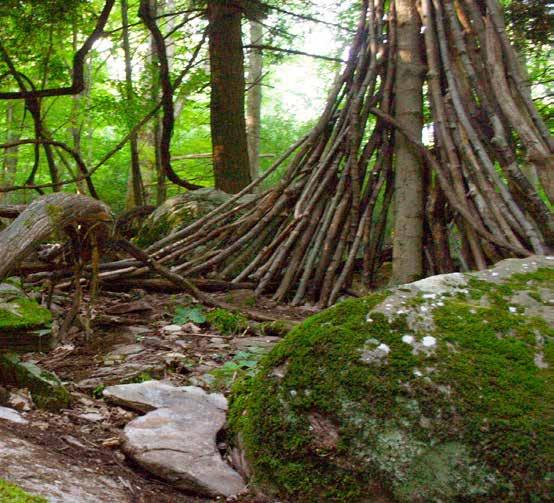 Miranda Schmidt
Miranda Schmidt


